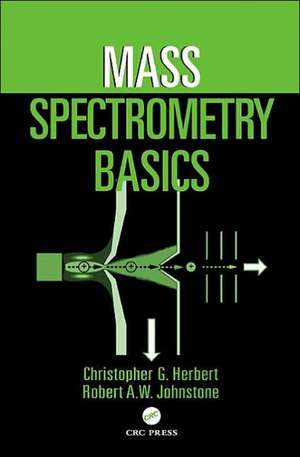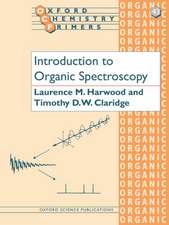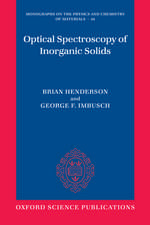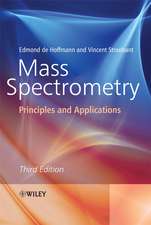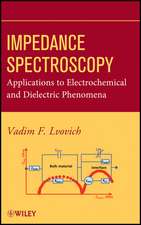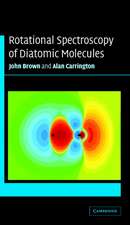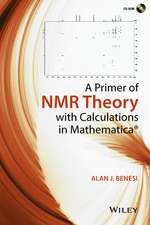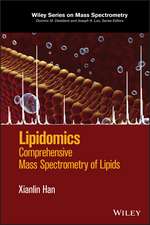Mass Spectrometry Basics
Autor Christopher G. Herbert, Robert A.W. Johnstoneen Limba Engleză Hardback – 26 iun 2002
This unique reference makes some of the esoteric aspects of this important area of analysis more readily comprehensible to those who deal with analytical instruments but who have not been trained in mass spectrometry. It also serves as a refresher for practicing mass spectroscopists by clarifying principles to afford a better appreciation and application of this technology.
Preț: 1953.40 lei
Preț vechi: 2382.19 lei
-18% Nou
Puncte Express: 2930
Preț estimativ în valută:
373.78€ • 407.29$ • 314.97£
373.78€ • 407.29$ • 314.97£
Carte tipărită la comandă
Livrare economică 23 aprilie-07 mai
Preluare comenzi: 021 569.72.76
Specificații
ISBN-13: 9780849313547
ISBN-10: 0849313546
Pagini: 496
Ilustrații: 54 equations; 20 Tables, black and white; 301 Illustrations, black and white
Dimensiuni: 178 x 254 x 31 mm
Greutate: 1.24 kg
Ediția:1
Editura: CRC Press
Colecția CRC Press
ISBN-10: 0849313546
Pagini: 496
Ilustrații: 54 equations; 20 Tables, black and white; 301 Illustrations, black and white
Dimensiuni: 178 x 254 x 31 mm
Greutate: 1.24 kg
Ediția:1
Editura: CRC Press
Colecția CRC Press
Public țintă
ProfessionalCuprins
Chemical Ionisation. Laser Desorption Ionisation. Electron Ionisation. Fast Atom Bombardment (FAB) and Liquid Phase Secondary Ion Mass Spectrometry (LSIMS) Ionisation. Field Ionisation and Field Desorption. Coronas, Plasmas and Arcs. Thermal Ionisation. Electrospray Ionisation. Atmospheric Pressure Ionisation. Z-Spray Combined Inlet/Ion Source. Thermospray and Plasmaspray Interface. Particle-Beam Interface. Dynamic FAB LSIMS Interface. Plasma Torches. Sample Inlets for Plasma Torches Parts A, B, C: Gases, Liquid Inlet, Solid Inlets. Lasers and Other Light Sources. Nebulizers. Hybrid Orthogonal-TOF Instruments. Hybrid Magnetic Sector-TOF. Hybrid Hexapole-TOF. Hybrid Quadrupole-TOF. Ion Optics of Magnetic/Electric Sector MS. Quadrupole Ion Optics. TOF Ion Optics. Orthogonal TOF Ion Optics. Point Ion Collectors. Array Collectors. Comparison of Multipoint Ion Collectors. Time-to-Digital Converters. Origin and Uses of Metastable Ions. Linked Scanning and Metastable Ions in Quadrupole MS. Linked Scanning and Metastable Ions in Magnetic Sector MS. Gas and Liquid Chromatography. GC/MS. LC/MS. HR Accurate Mass-Elemental Composition. Choice of Mass Spectrometer. Analysis of Peptides and Proteins by MS. EPA Protocols. Computers and Transputers in MS, Parts A, B, C. An Introduction to Biotechnology. Isotopes and MS. Use of Isotope Ratios. Variations in Isotope Ratios. Transmission of Ions through Inhomogeneous RF Fields. Appendices.
Recenzii
"This book is intended … as a brief primer on the many flavors and applications of MS technology. As such, the novice will walk away with a taste of MS while the seasoned pioneer will see this book as a quick reference. … [T]he book sets the reader up to read … more complex books down the road. And each chapter is spiced with figures, tables, and schematics that help the reader understand how this technology comes together."
- Today's Chemist at Work
"…can be used by all categories of readership…The book is developmental in nature - beginning with basics of the process and proceeding stepwise to more detailed analyses of each aspect of the method…Highly recommended"
L. Andersson, Big Bend Community College, in CHOICE Magazine.
Promo Copy
- Today's Chemist at Work
"…can be used by all categories of readership…The book is developmental in nature - beginning with basics of the process and proceeding stepwise to more detailed analyses of each aspect of the method…Highly recommended"
L. Andersson, Big Bend Community College, in CHOICE Magazine.
Promo Copy
Notă biografică
Herbert, Christopher G.; Johnstone, Robert A.W.
Descriere
Omitting elaborate mathematical derivations, Mass Spectrometry Basics provides authoritative explanations of the basic concepts of this powerful analytical method. The authors describe processes, applications, and the underlying science in a concise manner supported by figures and graphics that further readers' comprehension. The text provides practical approaches to interpreting mass spectral data and step-by-step guides for identifying chemically relevant compounds. It also includes an extensive reference section and a quick guide to each chapter that offers immediate access to key information.
